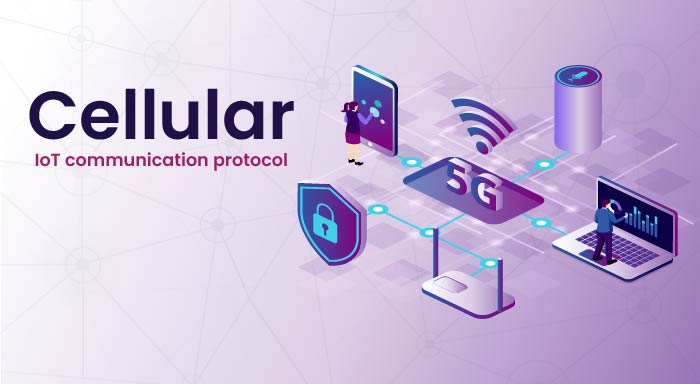Introduction
In the ever-developing world of IoT, connectivity might be considered one of the most crucial links that enhance the performance of devices in various environments. The main challenge will be to identify the highest efficient communication protocol as IoT continues to develop.
As one might observe, cellular is a reliable and expandable solution, particularly helpful for devices that should operate at a considerable distance from one another or in regions with a poor connection or none at all.
In this blog, we will explore and discuss the following concepts: The role of cellular communication protocols in IoT, the advantages and opportunities of the same, as well as the use cases of cellular communication in various sectors.
What is cellular communication in IoT?
Cellular communication in IoT means the usage of the mobile network standards, for example, 4G and 5G, in connecting IoT devices to the Internet. These networks use the infrastructure of cellular telephones and offer large coverage and good connectivity.
Considering the example of smart cities, agriculture, or transportation, commuters know how reliable cellular solutions are because they can connect a vast number of devices via various IoT levels.
Communication protocols in the Internet of Things
Communication protocols in IoT are essential to define how data is transmitted and received among devices. Standards guarantee that the interchange of data is properly and effectively done from one system to another.
When it comes to cellular IoT, protocols including the Message Queuing Telemetry Transport (MQTT), Constrained Application Protocol (CoAP), and Hypertext Transfer Protocol (HTTP)are used to help the devices and platforms to communicate.
These protocols have been customized to address the specific issues that are associated with IoT including low power consumption and limited bandwidth.
Benefits of using Cellular Communication in IoT:-
1. Wide Area Coverage:
Geographical connectivity is another advantage offered by cellular networks; Building blocks of IoT and IoT devices can thus be connected and can communicate over large geographical areas. That is especially advantageous when used in areas that involve an exchange of geography such as logistics or fleet management applications.
2. Reliability and Security:
Some of the very fundamental aspects of forming a Cellular Network are peace of data built through stringent security measures incorporated and business continuity in a secure form through constant connectivity. This reliability is very important for such applications as monitoring patients' state in a hospital or emergency services.
3. Scalability:
Cellular IoT technology allows many connections at one time, therefore the IoT solutions are highly scalable. This is an advantage, particularly for smart city projects where thousands of sensors are required to connect.
Key Cellular Technologies in IoT
Narrowband IoT (NB-IoT):
It is mainly for IoT use and has good penetration both indoors and in rural areas which makes it a good candidate for smart metering and environment monitoring.
LTE-M (Long-Term Evolution for Machines):
LTE-M has better bandwidth than NB-IoT and supports mobility; some use cases are asset tracking and smart wearables.
5G Technology:
Collecting data over broad areas, 5G offers high bandwidth and low latency; the technology is expected to drastically change IoT to include real-time information processing and real-time applications such as self-driving automobiles and smart production lines.
Cellular Communication Protocol in IoT
1. Smart Agriculture:
In rural areas, cellular IoT networks are used to communicate with IoT devices that are responsible for controlling crop health, the conditions of the soil, and weather data. However, through using communication protocols in IoT such as MQTT and CoAP farmers amongst others can use real-time data and act accordingly to enhance yield and minimize wastage.
2. Healthcare Monitoring:
Telecommunication networks allow wearable devices and remote monitoring systems to ship patient details to healthcare providers. It is useful for constant health checks, notification systems, and patient-centered care plans.
3. Industrial Automation:
Industrial IoT devices use cellular protocols to ensure the automation of industrial processes, real-time tracking, and anticipated maintenance. 5G specifically improves these applications for the necessary bandwidth and latency.
4. Smart Cities:
Some of the applications of smart cities include traffic control systems, emergency alerts, and notifications among others made through cellular networks and access control of IoT devices. Through basics such as MQTT and HTTP, it is possible to have a protocol to ensure real-time data transfer and better management of cities.
Challenges and Considerations
Nevertheless, there are some issues one has to face when applying cellular protocol in IoT. Cellular services can be quite expensive, thus affecting projects that may not be very financially buoyant. Energy is another factor for IoT devices especially batteries especially those that use NB-IoT which has come a long way in minimizing the energy demand.
Future of Cellular Communication in IoT
As IoT continues to evolve, cellular communication protocols will play an increasingly crucial role. The future lies in technologies like 5G and the forthcoming 6G, which promise to deliver unprecedented speed and connectivity, enabling complex IoT ecosystems. By addressing current challenges and harnessing the advancements in cellular networks, the potential for innovation in IoT is limitless.
Conclusion
In conclusion, cellular protocol in IoT offer robust and scalable solutions for diverse applications. As technology advances, these protocols will continue to drive efficiency, connectivity, and innovation across industries, paving the way for a more connected world.



